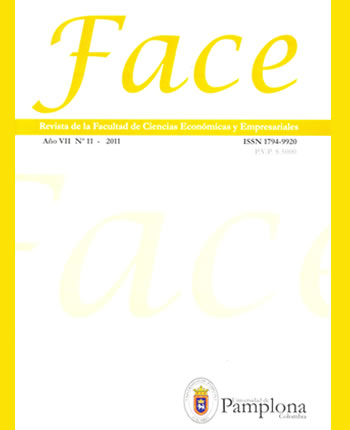COMPOSICIÓN DEL BUSCADOR DE EMPLEO STOCK EN CASACIÓN DEL MERCADO LABORAL: UN ENFOQUE DE FRONTERA ESTOCÁSTICA
DOI:
https://doi.org/10.24054/face.v11i1.1820Keywords:
correspondencia de función, eficacia técnica, análisis estocástico fronterizo, mercados de trabajo locales y heterogeneidadAbstract
Este trabajo investiga la eficiencia técnica del mercado de trabajo coincidente con un enfoque de frontera estocástica. El conjunto de datos consiste en datos mensuales de 145 oficinas de trabajo locales (Llos) en Finlandia durante el periodo 1995/01-2004/09. El verdadero modelo de efectos fijos es utilizada para cruzar por separado la heterogeneidad de la sección de la ineficiencia. Según los resultados, hay diferencias notables en la adecuación de eficiencia entre las regiones, y estas diferencias contribuyen de manera significativa el número de vacantes cubiertas. Si todas las regiones eran tan eficaces como el más eficiente, el número de
partidos totales por mes se incrementaría en más del 10%. Si la ineficacia no tenía ningún papel en la función de concordancia, el número de partidos, aumentaría en casi un 24%. El peso de la composición de la población solicitante de empleo y otras variables ambientales en la determinación de hacer coincidir la ineficiencia es en promedio del 61%. En particular, los solicitantes de empleo de la fuerza de trabajo altamente educada y de los solicitantes de empleo de mejorar la eficiencia técnica en la función correspondiente.
Downloads
References
Anderson, P. and Burgess, S. (2000) Empirical matching functions: Estimation and
interpretation using state-level data. The Review of Economics and Statistics, 82, 93-
· Battese, G.E. and Coelli, T.J. (1995) A model for technical inefficiency effects in a
stochastic frontier production function for panel data. Empirical Economics, 20, 325-
· Blanchard, O. and Diamond, P. (1989) The Beveridge curve. Brookings Papers on
Economic Activity, 1, 1-76.
· Blanchard O. and Diamond P. (1994) Ranking, unemployment duration, and wages.
Review of Economic Studies, 61, 417-434.
· Broersma L. (1997) Competition between employed and unemployed job searchers: is
there a difference between the UK and The Netherlands? Applied Economics Letters,
, 199-203.
· Broersma, L. and Van Ours, J. (1999) Job searchers, job matches and the elasticity of
matching. Labour Economics, 6, 77-93.
· Budd A., Levine P., and Smith P. (1988) Unemployment, vacancies, and the long-term
unemployed. Economic Journal, 98, 1071-1091.
· Burgess S. (1993) A model of competition between unemployed and employed job
searchers: an application to the unemployment outflow rate in Britain. Economic
Journal, 103, 1190-1204.
· Burgess S. and Turon H. (2003) Unemployment equilibrium and on-the-job search.
IZA Discussion Paper No. 753.
· Coelli, T. (1997) A guide to FRONTIER Version 4.1: A Computer program for
stochastic frontier production and cost estimation. CEPA Working paper 96/07.
· Coelli, T., Perelman, S., and Romano, E. (1999) Accounting for environmental
influences in stochastic frontier models: with application to international airlines.
Journal of Productivity Analysis, 11, 251-273.
· Coelli, T., Rao D.S., and Battese G. (1998) An introduction to efficiency and
productivity analysis. Kluwer Academic Publishers.
· Fahr, R. and Sunde, U. (2002) Estimations of occupational and regional matching
efficiencies using stochastic production frontier models. IZA Discussion paper 552.
· Fahr, R. and Sunde, U. (2005) Regional dependencies in job creation: an efficiency
analysis for western Germany. IZA Discussion paper 1660.
· Farrell, M.J. (1957) The measurement of productive efficiency. Journal of the Royal
Statistical Society Series A, 120(3), 253-290.
· Gautier, P., van den Berg, G., Van Ours, J., and Ridder, G. (2002) Worker turnover at
the firm level and crowding out of lower educated workers. European Economic
Review, 46, 523-538.
· Giannakas, K., Tran, K., and Tzouvelekas, V. (2003) On the choice of functional form
in stochastic frontier modelling. Empirical Economics, 28, 75-100.
Greene, W. (2005a) Fixed and random effects in stochastic frontier models. Journal of
Productivity Analysis, 23, 7-32.
· Greene, W. (2005b) Reconsidering heterogeneity in panel data estimators of the
stochastic frontier model. Journal of Econometrics, 126, 269-303.
· Gregg and Petrongolo (2005) Stock-flow matching and the performance of the labor
market. European Economic Review, 49, 1987-2011.
· Hynninen, S., Kangasharju, A., and Pehkonen, J. (2006). Regional Matching Frictions
and Aggregate Unemployment. VATT Discussion Paper 383.
· Hynninen, S. and Lahtonen, J. (2007) Does population density matter in the process of
matching heterogeneous job seekers and vacancies? Forthcoming in Empirica.
· Hämäläinen H. (2003) Työvoiman rekrytointi toimipaikoissa vuonna 2002, [in Finnish],
Ministry of Labour, Helsinki.
· Ibourk, A., Maillard, B., Perelman, S., and Sneessens, H. (2004) Aggregate matching
efficiency: A stochastic production frontier approach, France 1990-1994. Empirica, 31,
-25.
· Ilmakunnas, P. and Pesola, H. (2003) Regional labour market matching functions and
efficiency analysis. Labour, 17 (3), 413-437.
· Kim, Y. and Schmidt, P. (2000) A review and empirical comparison of Bayesian and
classical approaches to inference on efficiency levels in stochastic frontier models with panel
data. Journal of Productivity Analysis, 14, 91-118.
· Kumbhakar, S. and Lovell, C.A. (2000) Stochastic frontier analysis. Cambridge
University press.
· Lahtonen, J. (2006) Matching heterogeneous job seekers and vacancies: Empirical
studies using Finnish data. Jyväskylä Studies in Business and Economics 50.
· Layard R. and Bean C. (1989) Why does unemployment persist? Scandinavian Journal
of Economics, 91, 371-396.
· Mumford K. And Smith P. (1999) The hiring function reconsidered: on closing the
circle. Oxford Bulletin of Economics and Statistics, 61, 343-364.
· Petrongolo B. and Pissarides C. (2001) Looking into the black box: a survey of the
matching function. Journal of Economic Literature, 39, 390-431.
· Pissarides C. (1992) Loss of skill during unemployment and the persistence of employment
shocks. Quarterly Journal of Economics, 107, 1371-1391.
· Pissarides C. (1994) Search unemployment with on-the-job search, Review of
Economic Studies, 61, 457-475.
· Pissarides C. (2000) Equilibrium unemployment theory, MIT Press.
· Sicherman, N. (1991) “Overeducation” in the labor market. Journal of Labor
Economics, 9, 101-122.
· Van Ours J. (1995) An empirical note on employed and unemployed job search.
Economics Letters, 49, 447-452.
· Van Ours, J. and Ridder, G. (1995) Job matching and job competition: Are lower
educated workers at the back of queues? European Economic Review, 39, 1717-1731.





